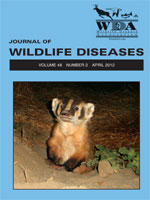Chlamydiae are obligate, intracellular, gram-negative bacteria that are responsible for important diseases in humans, other mammals, and birds. Studies have shown that chlamydiae could be present in wild ruminants, but the serodiagnostic method most commonly used did not allow identification of chlamydial species. We determined the prevalence of antibodies to Chlamydia pecorum, Chlamydia suis, Chlamydia abortus, and Chlamydia psittaci in 271 red deer (Cervus elaphus) of a central Italian population, by using the microimmunofluorescence test that shows antibody response against genus-specific and species-specific antigens. No sera had detectable antibodies to C. pecorum and C. abortus. Antibodies were detected against C. psittaci (9.6%) and C. suis (3.3%). Antibody response could be related to contact of the red deer with birds and wild boars (Sus scrofa), respectively, and confirm an extended host range of individual Chlamydia species. In view of the potential zoonotic risk related to exposition of C. psittaci, our findings suggest surveillance of wild ruminants as potential reservoirs for chlamydiae.
How to translate text using browser tools
1 April 2012
Chlamydiosis: Seroepidemiologic Survey in a Red Deer (Cervus elaphus) Population in Italy
Antonietta Di Francesco,
Manuela Donati,
Sandro Nicoloso,
Lilia Orlandi,
Raffaella Baldelli,
Daniela Salvatore,
Giuseppe Sarli,
Roberto Cevenini,
Federico Morandi
ACCESS THE FULL ARTICLE

Journal of Wildlife Diseases
Vol. 48 • No. 2
April 2012
Vol. 48 • No. 2
April 2012
antibody prevalence
chlamydiae
Italy
microimmunofluorescence test
red deer




